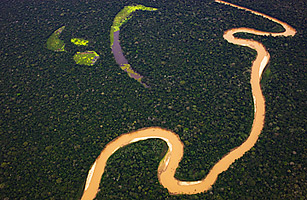
Deep in the Chiquitana tropical dry forest in southeast Bolivia, Noine Picanerai stands on a dirt road that cuts through lush woods. The 50,000-acre plot looks like a protected reserve. But, notes Picanerai, a woodsman in his 70s, “My people live off selling these trees.” Indeed, despite the forest’s pristine appearance, it’s a logging concession run by an indigenous Ayoreo community. The project, along with dozens of similar forest management programs across the Amazon region north of Bolivia, are making sustainable logging a reality instead of an oxymoron. “We aren’t like the other guys,” Picanerai says with a toothless grin. “We make sure the forest stays standing.”
Each year more than 30 million acres of the world’s natural forest are cut to satisfy global demand for wood and paper products. That deforestation, which reduces the planet’s carbon dioxide-absorbing foliage, causes at least a fifth of all greenhouse gas emissions today. South American forest management projects — logging that assures tree regeneration — are quietly growing into key conservation strategies in the fight against climate change. “These programs are about making the standing forest worth something to governments and communities,” says Meg Symington, managing director for the Amazon for the World Wildlife Fund-USA, which supports sustainable forestry.
Bolivia, specifically its indigenous communities and their NGO advocates, has been a pioneer of this effort, and communities in Brazil, Peru and the Guyanas have jumped on board as well. The Chiquitana venture, established in 2001 in the town of Zapoco by the Ayoreos and an NGO called APCOB, with government approval and monitoring, was Bolivia’s first indigenous-run forestry business. Its goal is to help save the dry forest — which is South America’s second-largest eco-system behind the Amazon rain forest, but whose trees are being felled at a faster rate than others on the continent — while giving the rural poor a shot at a living wage.
Each year for 20 years, the Zapoco cooperative has license to log 2,500 acres filled with rosewood, tigerwood, caviuna and other exotic tree species for export to the U.S. and Europe. A tree census plots out the logging before it begins, and only mature trunks of a certain diameter are marked for chopping, while younger trees are left to grow and the healthiest of the lot are spared so their seeds can spread. “That one wasn’t cut because it’s got a parrot’s nest,” says Pedro Charupas, another Zapoco resident, motioning to a fully mature ironwood.
Zapoco, a town of 65 families managed by a council of elders, was founded in the late 1940s when Evangelical missionaries brought the nomadic Ayoreos into “civilization.” But this is the first time since then that the community has been financially stable. “Our forestry project works because we know how to live and work with the forest,” says Picanerai. The benefits stay in the community. “I buy food and clothes for my family with my stipend,” says Juanita Chiqueo, a mother of five, who as a resident gets an average annual payment of $150 from the cooperative, which employs most of the town. Its profits also pay for schools, healthcare and trucks for the business. “When people outside Zapoco first saw our pick-up,” says a laughing Picanerai, “they said, ‘Oh, they must be trafficking drugs.'”